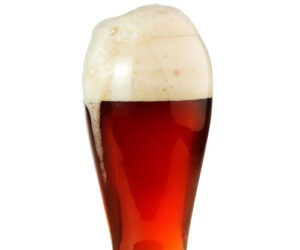Old Ale
Old ales are strong, almost always dark ales that are sometimes known as strong ales. They are English in origin and range from the Eldridge Pope brewery’s famed Thomas Hardy’s ale, which at 12 percent alcohol by volume is considered part strong ale and part barleywine, to Young’s Winter Warmer at 5.2 percent. From just these two examples you can see the diversity within the category of old ales.
Although Hardy’s and other very high-gravity, cellaring-type beers are the exception, the rest of the field take their cue from them. Most old ales are highly hopped for balance, and many contain 6 percent alcohol by volume or more. If properly bottle conditioned, these strong ales can age for extended periods. Many manufacturers of this style use the titles “old” and “strong” interchangeably. There seems to be a fairly reliable distinction between some classic examples, however.
The style guidelines for old ale are: original gravity 1.055 to 1.126 (13.75° to 31.5° Plato), final gravity 1.010 to 1.040 (2.5° to 10° Plato), bitterness 24 to 80 IBUs, color 10° to 80° SRM, and alcohol by volume 5.3 percent to 11 percent.
As you can see, the category is fairly open to interpretation, allowing the brewer to create almost anything to fit the style. To perfectionists, this presents a problem. Style guidelines for color and bitterness are wide open, so the only numbers that make this beer an old ale are the high gravity and alcohol.
Our old ale will be in the middle of the style guidelines, with a target original gravity of 1.080 (20° Plato), bitterness 40 IBUs, alcohol by volume at 8.7 percent, and final gravity of 1.012 (3° Plato). Color will be at least 80° SRM, or black with some deep reds if held up to bright light.
Semantically there are many strong ales in production, but just because a beer happens to have a high alcohol content does not mean that it should automatically be classified as an old ale. In general old ales should be classically English in ingredients and character and for the most part be dark, rich, alcoholic ales.
Formulation — Malt
Many traditional ales of very high gravities, say more than 1.072 (18° Plato), are produced by separating the run-off into first and second runnings. This is sometimes known as parti-gyle brewing. It means that the first part of the run-off is collected for the stronger ale, and the end portion of the wort is used for a weaker or “small” beer.
That will not be the method used here, as a specific recipe is given for our old ale. But you can easily practice the technique if you are brewing several successive brews close together (preferably of the same type). For example a porter recipe could become a stout (by the first runnings) and a brown or mild (by the second runnings). Thus a five-gallon recipe for your normal porter could yield two 2.5-gallon batches of the others. Most brewers only choose to use the parti-gyle system with very high gravity beer to conserve the end runnings, leaving ales of more ordinary gravity to the common brewing method.
This brings up another problem with mashing high-gravity beers and any beers with a great deal of grain: the size of the mash tun. Many homebrewers do not have a mash tun large enough to make five gallons of beer at a gravity higher than 1.072 (18° Plato). Anything larger tends to be overpacked, which leads to cool spots and poor extraction, not to mention a difficult run-off procedure because the mash tun is so full. In this case it is best to brew two half batches and blend them in fermentation.
Hops
Like any other English beer we brew, the hops for old ale should be of the U.K. variety. Kent Golding, Fuggle, Bramling Cross, Challenger, and other hops are all good selections. Typically Style of the Month recipes employ a Fuggle and Golding hops program. But this beer demands a bit higher bittering potential from early and middle hop additions, so Bullion has been chosen for that purpose, and Kent Goldings will finish the beer.
Fermenting High-Gravity Beers
There are several things to consider when fermenting high-gravity beers of all types. The first and perhaps most important is the yeast strain you will be using. Since this beer has an original gravity of only 1.080 (20° Plato), yeast strain really should not be an issue. But higher gravities can kill yeast (because the alcohol content gets so high).
Alcohol is a waste product to yeast and is toxic, and with high concentrations the yeast cells actually begin to die as a matter of osmotic pressure as the water inside tries to move to higher concentration. Depending on the yeast strain, it takes an alcohol content of anywhere from 7 percent to more than 12 percent to harm the yeast.
Choosing an alcohol-tolerant yeast is important, but there are several other ways to counter the outcome. For example you can pitch more yeast partway through fermentation, rousing with more oxygen, and even pitching a second type of yeast for finishing.
For our purposes the yeast recommended in the recipe (Wyeast 1098, British ale; or try White Labs WLP005, British ale) will work great, but it needs to be oxygenated as much as possible. That means if you have a stone for oxygenating, let it rip. And if you don’t have one, well, shake that carboy until your arms fall off.
If everything goes as planned, the fermentation should be finished in two weeks and should be starting to clear a bit after three weeks.
Comparisons
Beside the Young’s and Hardy’s old ales stand a variety of other old ales to try before brewing. Imports include Fuller’s 1845 and the legendary Theakston Old Peculier. Domestically, try Pyramid Snow Cap Ale and Dogwood Winter Ale (which is a darker black, like our old ale).
Old Ale
(5 gallons, all-grain)
OG = 1.080 (20° Plato) Bitterness = 40 IBUs Color = 80° SRM 8.6% ABV
Ingredients:
• 11.75 lbs. English two-row malt such as Beeston Maris Otter
• 0.5 lb. carapils or dextrin-type malt
• 2.5 lbs. crystal malt, 80° Lovibond
• 0.25 lb. chocolate malt
• 0.25 lb. roasted barley
• 1 oz. Bullion hops (8% alpha acid, 8 AAUs) for 90 min.
• 1.25 oz. Kent Golding hops (5.4% alpha acid, 6.8 AAUs): 0.75 oz. (4.1 AAUs) for 30 min., 0.5 oz. (2.7 AAUs) at end of boil
• 1 pt. yeast starter of Wyeast 1098 (British ale)
• 2/3 cup corn sugar for priming
Step by Step:
Mash grain in 4.75 gal. of 150° F water for 60 min. Sparge with enough 168° F water to yield 5.75 gal. of wort.
Total boil time is 90 min. At beginning of boil, add Bullion hops and boil 60 min. Add 0.75 oz. Kent Golding hops and boil 30 min. more. At end of boil, add remaining Kent Goldings. Whirlpool and cool to 69° F to pitch starter.
Ferment at 69° F for seven days, then rack to secondary fermenter. Continue fermentation for seven more days until gravity is about 1.012 (3° Plato). Prime and bottle. Age at least two more weeks before drinking.
Extract With Grains Option:
Substitute 9.5 lbs. pale malt syrup for pale malt. Specialty grains remain the same as above. Start with 5 gal. of water in boil kettle. Steep crushed grain at 150° F for 30 min. Remove bag and rinse with enough 168° F water to make 5.5 gal. Add extract. Total boil time is 60 min. At beginning of boil, add 1.25 oz. Bullion hops and boil 30 min. Add 0.75 oz. Kent Golding hops and boil 30 min. more. At end of boil add remaining Kent Goldings. Whirlpool and cool to 69° F to pitch starter. Follow fermentation schedule for all-grain version.



